IR/THz spectroscopy for space exploration
Sergio Ioppolo
Our group studies the formation and evolution of prebiotic molecules in the Universe by performing complementary novel laboratory experiments at the Antenna Measurement Laboratory and at larger facilities such as the free-electron laser FELIX Laboratory (an EPSRC National Research Facility) at the Radboud University Nijmegen in the Netherlands. The laboratory work aims to reproduce and understand the physico-chemical conditions that lead to the observed molecular complexity in star-forming regions in space and in our Solar System by using an unprecedented combination of different laboratory techniques. We currently carry-out other research programs at other facilities such as the synchrotron ASTRID2 at Aarhus University in Denmark and the ion accelerator ATOMKI at the Institute for Nuclear Research in Hungary.
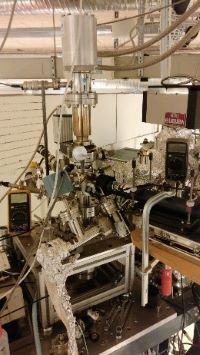
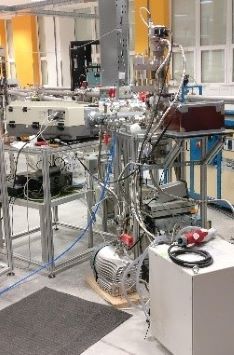
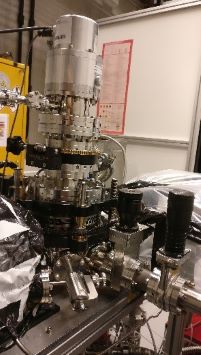
Figure 1: Pictures of PAC at ASTRID2 (left), ICA at ATOMKI (centre), and TeraC (right).
The ultrahigh vacuum TeraC system
How life on Earth originated and whether it exists elsewhere in the Universe are among the most important outstanding questions of humankind. A strong synergy among space science, astrochemistry, planetary science, geophysics, biology, and engineering is key to a better understanding of the initial conditions for the emergence of life on Earth. The recent advent of modern observatories (e.g., Atacama Large Millimeter and sub-millimeter Array (ALMA), Stratospheric Observatory for Infrared Astronomy (SOFIA), Herschel Space Observatory (Herschel), and Spitzer Space Telescope (Spitzer)) combined to complementary progresses in astrochemical models and laboratory experiments have allowed for the identification of more than 200 molecules in the interstellar and circumstellar medium (ISM/CSM). Meanwhile in the Solar System, tens of indigenous amino acids, fatty acids, and nucleobases have been found in meteorites and many complex organic molecules (COMs) have been detected in comets. Our work aims to bridge the gap between our understanding of molecule formation in the ISM and the observed inventory of life-related species in our Solar System.
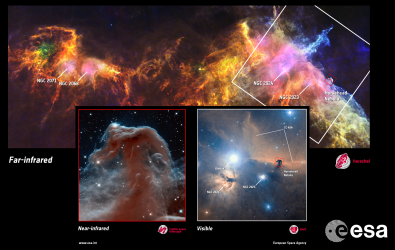
Figure 2: Horsehead nebula observed at different frequencies [credit to ESA].
At the Antenna Measurement Laboratory we develop and implement THz gas/solid-phase novel spectroscopic techniques as tools for understanding the physical-chemical properties of the ISM. An ultra-high vacuum (UHV) system (Terahertz Chamber – TeraC) has been commissioned to perform experiments on formation and destruction of prebiotic molecules such as glycine and other amino acids in interstellar ice analogues. The apparatus acquires IR/THz spectra of the ice samples both in transmission and reflection. Ices are deposited at temperatures between 10-300 K on a substrate connected to a closed-cycle helium cryostat. The system comprises a 1 keV electron gun and a hydrogen atom source to simultaneously and sequentially study ‘energetic’ and ‘non-energetic’ ice processing. Until recently, exploring the physics and chemistry of low temperature (>10 K) condense phase matter was limited because standard spectroscopic techniques, e.g., FTIR and mass spectrometry, could not unambiguously detect high molecular complexity in ISM relevant ices (e.g., spectral confusion in the mid-IR), or were hampered by ion fractionation in the gas phase, and neither technique was sensitive to dynamical processes in ices (e.g., diffusion, reaction and desorption). THz time-domain techniques developed at the Antenna Measurement Laboratory will enable the unambiguous detection of COMs in the ice through their lattice and torsional modes as well as the study of time-resolved dynamics within ice layers.
The ultrahigh vacuum LISA end-station at FELIX Laboratory
The Free-Electron Lasers for Infrared eXperiments (FELIX) Laboratory user facility (https://www.ru.nl/felix/) exploits intense, short-pulsed infrared (IR) and terahertz (THz) free-electron lasers to investigate their interaction with molecules and materials, while creating extreme conditions and driving matter into previously inaccessible phases with myriad applications in analytical ion spectroscopy, astrochemistry, cluster science, ion chemistry/mass spectrometry, and magneto-optics. Dr. S. Ioppolo is the sole responsible for the Laboratory Ice Surface Astrophysics (LISA) end-station at the FELIX Laboratory. Over the last five years, Dr. Ioppolo has developed, constructed, and managed LISA, an ultrahigh vacuum (UHV) setup designed and optimized to perform selective IR/THz radiation of space relevant molecules in the solid phase when coupled to FEL-1 and FEL-2. Dr. Ioppolo is a regular user at FELIX and he has supported international external users in securing their beamtime and performing their experiments with LISA.
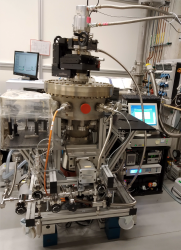
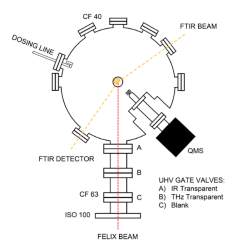
Figure 3: Picture (left) and schematic top-view (right) of the LISA end station at FELIX Laboratory.
LISA end-station is currently located in the multi-purpose station with optical table (User Station 8, https://www.ru.nl/felix/facility/measurement-station/). A dedicated UHV dosing line is used to prepare pure gases and gas mixtures prior to their dose inside the main chamber. Gas mass-independent gauges are used during gas mixture preparation to ensure reproducibility of selected mixing ratios. The dosing line is designed to deposit simple inorganic as well as complex organic space relevant species. Gases are introduced in the main chamber through an all-metal leak valve and deposited via background deposition onto a custom-made oxygen-free high thermal conductivity (OFHC) copper substrate at the center of the chamber with an optically flat face coated in gold to ensure maximal reflection in the IR-THz spectral range. In thermal contact with the substrate, a closed-cycle helium cryostat system is coupled to a silicon diode, cartridge heaters and a temperature controller to regulate the substrate temperature in the range 15-300 K. A rotation stage and an XYZ-manipulator are used for alignment purposes and to allow FEL irradiation of the gold-coated surface at different spots of the substrate. In this configuration, once a selected ice is deposited, FELIX irradiation can be carried-out at multiple unirradiated spots of the same deposited ice, maximizing the use of beamtime shifts and allowing for more systematic and reproducible studies. A series of windows of different materials mounted on UHV gate valves are placed in series together with a blank gate valve in the FEL beam path before the chamber to allow for a faster change between FEL-1 and FEL-2 during a single shift (i.e., 8 hours of beamtime) with no need for opening the vacuum line. Analytical tools used at present are a Fourier-Transform Infrared spectrometer (Bruker Vertex 80v) configured in reflection-absorption mode to monitor the ice in-situ, and a residual gas analyzer mass spectrometer (Hiden Analytical) facing the substrate to detect molecules desorbing from the ice surface by means of thermal and/or IR/THz vibrationally excited desorption. A 5 keV electron gun (Kimball Physics) used for the energetic processing of selected samples and an OLED Effusion Cell (CreaTech) employed to deposit more refractory material such as PAHs are available upon request to users. Thus far, LISA has demonstrated unique capabilities at FELIX Laboratory being used to investigate selective IR-induced spectral changes in interstellar ices, phase change behavior in specific interstellar molecules, selective IR-induced diffusion of interstellar molecules, desorption induced upon vibrational excitation of interstellar molecules, energy transfer induced by excitation and propagation of vibrational modes, and selective IR-induced chemistry in PAHs.
Highlights and Research Outcomes
2021 COSPAR 2021, Sydney, Australia
2019 3rd FLUENCE Workshop at FELIX, Nijmegen, The Netherlands
2019 FELIX: Free Electron Lasers for the Catalysis Community, Harwell, Didcot, UK
2018 COSPAR 2018, Pasadena, USA
2017 Astrochemistry in the THz domain, Chennai, India
2017 Evolution of Molecules in Space, Symposium at the Hokkaido University, Sapporo, Japan
Selected Research Grants and Projects
2020 Royal Society University Research Fellowships Renewals 2019
2018 Royal Society Research Grant 2018/R1
2018 ISA – CALIPSOplus transnational access programme (User)
2017 FLUENCE – Felix light for the UK: Exploiting novel characteristics and expertise (User)
2017 Royal Society Research Fellow Enhancement Award 2017
Selected Recent Publications
-
Ioppolo, S., Kaňuchová, Z., James, R.L., Dawes, A., Ryabov, A., Dezalay, J., Jones, N.C., Hoffmann, S.V., Mason, N.J., Strazzulla, G.; “Vacuum ultraviolet photoabsorption spectroscopy of space related ices: formation and destruction of solid carbonic acid upon 1 keV electron irradiation”, 2021, Astron. Astrophys., 646, A172.
-
Ioppolo, S., Fedoseev, G., Chuang, K.-J., Cuppen, H.M., Clements, A.R., Jin, M., Garrod, R.T., Qasim, D., Kofman, V., van Dishoeck, E.F., Linnartz, H.; “A non-energetic mechanism for glycine formation in the interstellar medium”, 2021, Nature Astronomy, 5, 197.
-
James, R.L., Ioppolo, S., Hoffmann, S.V., Jones, N.C., Mason, N.J., Dawes, A.; “Systematic investigation of CO2:NH3 ice mixtures using mid-IR and VUV spectroscopy - Part I: thermal processing”, 2020, RSC Advances, 10, 37515.
-
Noble, J.A., Cuppen, H.M., Coussan, S., Redlich, B., Ioppolo, S.; “Infrared resonant vibrationally induced restructuring of amorphous solid water”, 2020, Journal of Physical Chemistry C, 124, 20864.
-
Ioppolo, S., Kaňuchová, Z., James, R.L., Dawes, A., Jones, N.C., Hoffmann, S.V., Mason, N.J., Strazzulla, G.; “Vacuum ultraviolet photoabsorption spectroscopy of space related ices: 1 keV electron irradiation of nitrogen- and oxygen-rich ices”, 2020, Astron. Astrophys., 641, A154.

